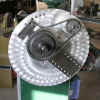| Botula Bollinger Ovalturning Lathe Dan Bollinger West Lafayette, Indiana, USA |
|
|
| I spent the last 2 years, on and off,
researching and designing this lathe. During that research I ran across the epicyclic oval
turning chuck designed by Prof. Johannes Volmer. The mechanism is inherently
balanced and can operate at higher speeds than any other elliptical chuck. I liked
Volmer's concept for many reasons including high speed, low noise and low vibration. I
didn't think they would work well when scaled up to the size I wanted, so I started from
scratch designing a new mechanism. I want to turn large, long, skinny shaped bowls and boxes and not even the largest Volmer chuck is large enough. So, I decided to make my own ovalturning lathe from the ground up. There are cost, performance and vibration benefits from making the elliptical mechanism integral to the lathe, so I did this instead of making a removable chuck. It uses an epicyclic mechanism, 2Hp/3-phase motor with VFD, 1.5" hardened, solid shaft running in a double tapered roller main bearing. I added a circular indexer just in case I may want that feature later on. The secondary shaft is threaded 1" x 1/8"tpi to accept standard faceplates and chucks. This lathe will swing 82" and sway* 24." That means that I can turn aN 32" long bowl that is only 8" wide (32-24=8), or an 82" long bowl that is 58" wide. With minor alterations, it will sway as much as 28." An ellipse has two centers or focii. What this mechanism does is rotate the workpiece on two shafts simultaneously. The cogged belts and sprockets keep the mechanism timed. The second shaft revolves at half the rpm of the first; the result generates an ellipse. The mechanism is integral to the pedestal making this an elliptical-turning lathe and not an elliptical chuck. (A chuck can be removed and reinstalled easily and even shared between machines) As far as I know, this lathe will have the largest sway of any ovalturning lathe or chuck made. The oval picture frame lathes at the Old Schwamb Mill are also large oval lathes of unknown sway, but appear to sway about 12". My request to Old Schwamb Mill for this information went unanswered. * I coined the term sway to shorten the ungainly phrase ovalturners use to describe their turnings: "the difference between the major diameter and minor diameter of the oval workpiece is..." An ovalturning lathe or chuck is described in terms of its maximum sway. It sounds good with 'swing', too. |
||

